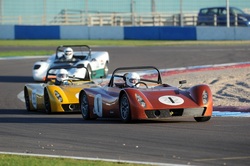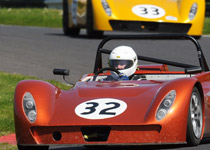Why am I bothering with all this certification lark? Well, last years 750 MC Sport Specials championship regulations, state in relation to Class C "The principle of this class is to limit the power to weight ratio to 340bhp/tonne. The competitor must supply a weight certificate, (car driver and drivers’ equipment) and power certificate with the completed registration form before the first race."
With a standard road car, it ought to be quite easy to work this out, but my car is far from a standard road car, and there are quite a few stumbling blocks in this seemingly easy to understand statement when it comes to working out how powerful & heavy my car is!
First of all, these are last years regulations, so this years ones may change. Mental note made.
Secondly, the regulations make the classic error of referring to a "power to weight ratio", but then they quote a maximum limit that uses units of measurement for Power (bhp) and Mass (Tonne), not Weight. Weight, according to Isaac Newton's 2nd Law of Motion that says Force = Mass multiplied by Acceleration. So the weight of an object with a mass of 1 kilogramme on earth where gravity can be measured at 9.80665 metres per second squared, is therefore 9.80665 Newtons. It is amazing how often you see this basic mistake made, mixing up units of weight and mass.
Thirdly, the 340bhp/tonne limit combines imperial power and metric units of mass. A metric tonne is 1000 kilos, equivalent to 2205 pounds while an imperial ton is 2240 pounds. Another mental note made.
Fourth, Power is referred to in bhp, or Brake Horse Power. At least they have stated the correct units this time! But what they have not stated is whether the bhp measurement is taken at the engine crankshaft (the number published by a car manufacturer or in a car magazine), or if they mean the bhp measurement taken from the driven wheels. Due to frictional losses, there is a difference which can vary substantially between vehicles, depending on the design and type of gearbox, differential, bearings, ancillary drives, and oils used; the difference between crank bhp and wheel bhp can be anywhere between 8% and 40%. It is impossible to estimate accurately. At least the 750MC rule writers did quote the units of power as bhp, as if they had not then there are a whole load of other pitfalls in interpreting which kind of Horsepower depending on if you are using imperial or metric units! I will assume that the rulemakers mean crankshaft bhp for the time being.
Finally, I must not forget to include my race overalls, boots, underwear, gloves, and crash helmet when I work out how "massive" I am!
With all these pitfalls in mind, I have reported the rule writers to the Society of Pedants!
Having only ever competed in series with very liberal rules (road legal tyres and an exhaust silencer present) I have never had to know the precise mass and power and never really cared about knowing either, the elapsed time and terminal speed of a quarter mile run were all the proof I needed. But before Novatech do the measurements, I thought it would be interesting to use some mathematics to estimate both figures, as then when I do go and measure the numbers we can see how close the mathematical estimates are.
To calculate Rear Wheel Horse Power (RWHP):
RWHP = ((mph/234)Cubed) x Mass in Pounds (lbs)
Same formula rearranged to calculate mph at the end of quarter mile:
mph = (Cube Root of (RWHP / mass in lbs)) x 234
To calculate the theoretical 1/4 mile Elapsed Time (ET):
ET = Cube Root of (Mass in lbs /RWHP) x 5.825
To calculate the theoretical Terminal Speed at end of a quarter mile:
Terminal Speed = Wheel Speed / 336.13 x Tyre Diameter (Inches)
The best 1/4 mile pass I ever managed in my Sylva was a low 12 at around 108mph. I am about 15 and a half stone, or about 98.5 kg. Based on known figures for other Furys I estimate mine at about 620kgs, so including me that's about 718.5kgs. When I plug in my quarter mile time and mph numbers to the above formulae they tell me that if the estimated mass is true, then the car must be making around 165bhp at the wheels, which if I make a guess at 25% frictional loss, translates to about 205bhp at the flywheel. This is rather disappointing if I am honest since the engine is supposed to be running QED cams alleged to produce 240bhp. But when I plug the gear ratios and tyre sizes into my gear ratio calculator the speeds in each gear it comes out at feel about right, and of course I have a timeslip with measured ET & mph.
So my estimates are about 205bhp at the crank and 718.5 kgs, from which I calculate a power to mass ratio of 286 bhp/tonne, too far inside the 340bhp/tonne limit to be competitive but plenty to be a lot of fun. If it was making 240bhp, then I would be right on the limit at 339bhp/tonne.
Anyhow, before I can get the car over to Bernie & Andy for certification (and to see if they can find any missing horses), I need to sort out the brakes. The brake pedal was like pressing on stone, with absolutely zero movement - I wasn't sure whether the bias valve was just way out of adjustment or whether the brake calipers, Wilwood 4 Pots, had seized up somewhat; everything else in the braking system seemed to be in good order. The brake bias was well out of adjustment, so i corrected it, but the pedal was still absolutely solid.
Having done a quick Google search for some advice on how to free them up, I came across a couple of good articles, one on how to do it using a grease gun trick and another great article on disassembling and rebuilding the calipers. But without a grease gun or a compressed air line to hand, I decided to simply use some muscle so got it the car again and pressed the brake pedal as hard as I could and they finally released!
And so today, I had a quick test drive in the Sylva for the first time in about 3 years! It ripped up through the gears and is quite windy with no lid on!! Still, that little reward of adrenaline is what keeps you going through a project like this. I even gave it a wash.












 RSS Feed
RSS Feed